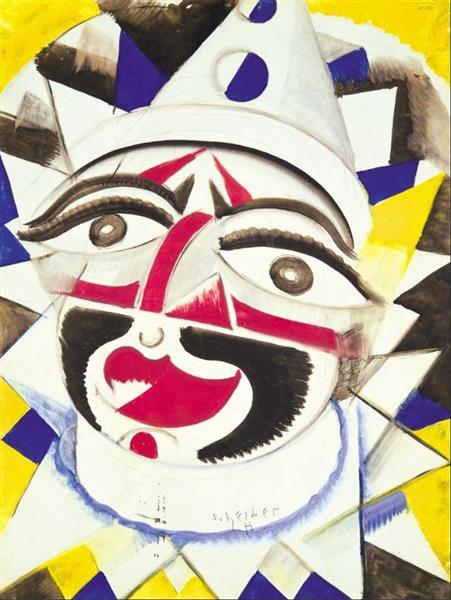Description
Hugó Scheiber, the Hungarian painter known for his style characterized by dynamism and geometrically simplified forms, offers us in his work "Nevet? Bohoc 1932 - 1932" An emotionally vibrant and visually shocking portrait. This painting, That dates from 1932, mastery represents the laugh of a clown, a recurring theme in the European interwar art, and is an excellent example of the artist's talent to merge figurative art with a modernist aesthetic.
The composition of the work is remarkable for its scenic and dynamic structuring. The central figure of the clown, with its prominent face triggered by black firm contours, takes possession of the pictorial space unfolding an open and uninhibited laugh. This laugh, however, does not seem completely destined for joy, but rather reveals an emotional complexity that ranges between happiness and melancholy, a counterpoint that is frequently addressed in the representation of jesters and clowns.
The use of color in this work is a testimony of Scheiber's domain over his palette. He uses a vibrant contrast between warm and cold tones, where the intense red of the clown's nose and lips come alive in front of deep blue and background white, creating a chromatic arrangement that captures and retains the viewer's attention. The shadows and lights are treated with a sensitivity that highlights the three -dimensionality of the figure without losing the stylization of its modernist approach.
The clown's eyes, treated with thick and decisive brushstrokes, seem to evoke an ambiguous emotional spectrum, suggesting a psychological depth under the surface of unbridled laughter. This is where Scheiber distances himself from mere comic portraits and delivers an introspective, almost metaphysical vision of the clown figure as a symbol of human duality, where public joy often hides a private sadness.
In the broadest context of Hugó Scheiber's work, "Bohoc 1932 - 1932" alínea with his tendency to represent figures of modern life under an optics that fuses the dynamism of futurism with the expressive simplification of the Art Deco. Its influences are palpable and varied, from Cubism to the expressionist movements of the moment, and this particular work reflects a tension between the form and content, deliberately using geometry to add an additional dimension to its human exploration.
The background, although relatively simplified, is not merely a void, but contributes to the theatrical aura of the scene, where the lonely clown against the invisible public carries the burden of their performance on its white shoulders. The choice of the blue background can also highlight the sensation of emotional depth, contrary to the most vivacious and necessarily expatriate face of the painting.
To fully appreciate Scheiber's work, it is essential to place it within the cultural and artistic maelstrom of his time, in which the artists were constantly redefining the relationship between form, color and emotion. "Bejet? Bohoc 1932 - 1932" is a piece that encapsulates its ability to synthesize those influences in a coherent and deeply evocative visual narrative. Hugó Scheiber invites us, then, to explore not only the visible surface of the clown's figure, but also the underlying layers of his emotions, reminding us that laughter and sadness, like the colors in his palette, are more intertwined than what They appear to the naked eye.
KUADROS ©, a famous paint on your wall.
Hand-made oil painting reproductions, with the quality of professional artists and the distinctive seal of KUADROS ©.
Art reproduction service with satisfaction guarantee. If you are not completely satisfied with the replica of your painting, we refund your money 100%.

